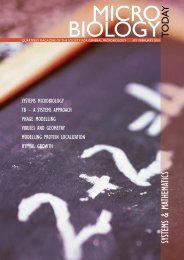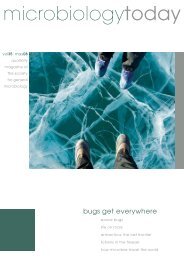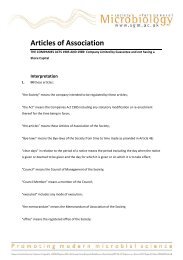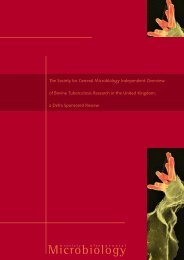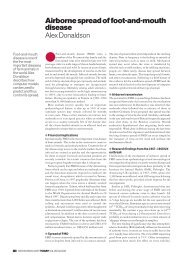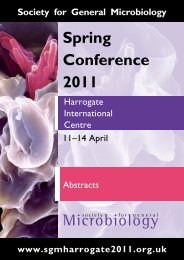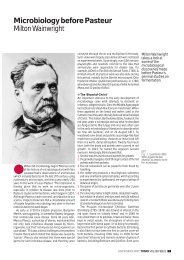Download - Society for General Microbiology
Download - Society for General Microbiology
Download - Society for General Microbiology
Create successful ePaper yourself
Turn your PDF publications into a flip-book with our unique Google optimized e-Paper software.
When living in a complex association with a<br />
nematode, the bioluminescent bacterium Photorhabdus<br />
can be deadly to insects, according to Susan A. Joyce<br />
and David J. Clarke.<br />
Photorhabdus:<br />
shedding light on<br />
symbioses<br />
Next time that you are on the beach, walk<br />
into the dunes and take a sample of the<br />
sandy soil within the area where the dune<br />
grass is growing. Place your soil sample<br />
in a flask, add a few insect larvae (readily<br />
available from your local bait or pet shop)<br />
and the chances are good that the insects will be dead<br />
within 2–3 days. Take these dead insects into the darkest<br />
room in your house and within 5–10 minutes you should<br />
see that some, if not all, of the insect cadavers will glow<br />
in the dark. This bioluminescence is due to the presence<br />
of the bacterium Photorhabdus, a highly virulent insect<br />
pathogen (entomopathogen) that you have isolated in a<br />
nematode vector from the soil. Together, Photorhabdus and<br />
the nematode vector (Heterorhabditis) <strong>for</strong>m a deadly complex<br />
that is naturally lethal to insect larvae.<br />
Photorhabdus are members of the family Enterobacteriaceae<br />
and are, there<strong>for</strong>e, quite closely related to familiar pathogens<br />
such as Escherichia coli, Salmonella, Yersinia and Erwinia spp.<br />
To date three species of Photorhabdus have been described;<br />
P. luminescens, P. temperata and P. asymbiotica. Although P.<br />
luminescens and P. temperata only appear to infect insects<br />
P. asymbiotica has been found, in a relatively small number<br />
m Insect larvae infected with Photorhabdus luminescens photographed<br />
in a dark room using the light produced by the bacteria. The<br />
insect hosts are final instar larvae of the greater waxmoth (Galleria<br />
mellonella). Susan Joyce (Sand dunes, Photos.com/Jupiter)<br />
of cases, to be associated with infections in humans. These<br />
infections, although not fatal, do result in rather serious<br />
wounds that are difficult to treat. Fortunately, these cases<br />
appear to be restricted to the southern states of the USA (in<br />
particular Texas) and the Gold Coast of Australia. However,<br />
it is rather intriguing that, under certain conditions Photorhabdus<br />
does appear capable of ‘jumping’ from insect to<br />
human. Interestingly, in the laboratory, most strains of P.<br />
luminescens and P. temperata do not grow at temperatures<br />
>32°C, whilst P. asymbiotica can grow at 37°C. There<strong>for</strong>e,<br />
perhaps the high ambient temperature of Texas and the Gold<br />
Coast has allowed P. asymbiotica to adapt to growth at the<br />
relatively high temperature of humans.<br />
Comparing the genomes of insect and human isolates of<br />
Photorhabdus may uncover some interesting insights into the<br />
evolution of mammalian pathogenicity in environmental<br />
micro-organisms. To this end, the genome sequence of P.<br />
luminescens TT01 has been available since 2003 (http://genolist.<br />
pasteur.fr/PhotoList) and the genome sequence of a strain of<br />
P. asymbiotica has just been completed<br />
at the Sanger Centre (www.sanger.ac.<br />
uk/Projects/P_asymbiotica/).<br />
Bioluminescence<br />
One of the most striking features<br />
of Photorhabdus bacteria is that they<br />
are bioluminescent and, indeed, it<br />
is this feature that gave the bacteria<br />
their name, i.e. photo (referring to the<br />
ability to produce light) and rhabdus<br />
(rod). Photorhabdus have a lux operon<br />
that contains all of the genes required<br />
<strong>for</strong> the production of light from fatty<br />
acids and molecular O 2<br />
, i.e. luxCDABE.<br />
The biochemistry of light production<br />
in bacteria is well described and it<br />
involves the conversion of a fatty acid<br />
into an aldehyde through the action<br />
of a fatty acid reductase (encoded by<br />
luxC and luxD). This reaction requires<br />
a supply of electrons that are delivered<br />
to the enzyme by the reduced electron<br />
carrier flavin mononucleotide (FMN).<br />
The aldehyde is then bound to the<br />
luciferase enzyme (encoded by luxA<br />
and luxB) which, together with O 2<br />
,<br />
<strong>for</strong>ms an unstable ternary complex<br />
that rapidly decomposes, releasing<br />
H 2<br />
O, fatty acid and energy in the<br />
<strong>for</strong>m of photons. The requirement <strong>for</strong><br />
electrons suggests that one function of<br />
light production may be to act as an<br />
electron shunt that allows the recycling<br />
of essential electron carriers without<br />
the production of ATP and/or biomass.<br />
Although bacterial bioluminescence is<br />
quite common in the marine environment,<br />
Photorhabdus is the only terrestrial<br />
bacterium that is known to produce<br />
light. In the sea, many light-producing<br />
bacteria are involved in symbioses<br />
with marine animals and the role of<br />
bacterial bioluminescence can vary<br />
from protection (counter-illumination<br />
in the Vibrio–squid symbiosis) to the<br />
attraction of a mate. Un<strong>for</strong>tunately the<br />
role of bioluminescence in Photorhabdus<br />
is not yet understood, although, as all<br />
isolated Photorhabdus strains produce<br />
light, it is likely that there is a strong<br />
selection <strong>for</strong> this activity.<br />
The life cycle<br />
Photorhabdus are normally found colonizing<br />
the guts of the infective juvenile<br />
(IJ) stage of the nematode Heterorhabditis.<br />
The IJ is a soil-dwelling, motile,<br />
non-feeding stage of the nematode<br />
whose role is to actively seek out and<br />
infect susceptible insect larvae and<br />
release the Photorhabdus into the insect<br />
bloodstream. Here the bacteria begin<br />
to divide whilst producing a wide<br />
range of toxins and hydrolytic enzymes<br />
that serve to kill the insect within 2–3<br />
days and facilitate the conversion of<br />
the internal organs and tissues of the<br />
insect into an environment where<br />
180 microbiology today nov 08 microbiology today nov 08 181



